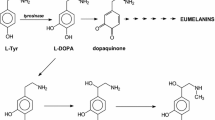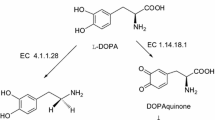Abstract
The study of excretion of tyrosine metabolites (p-hydroxyphenylpyruvic acid, homogentisic acid, total keto compounds) and of the tyrosine-aminotransferase activity of the organs and tissues of albino and black rabbits showed that the initial levels of the tyrosine metabolites in the urine of the black and albino rabbits differ only very little from each other. After oral administration of L-tyrosine the quantity of p-hydroxyphenylpyruvic acid excreted by the albino rabbits increased sharply, whereas that of homogentisic acid fell. In the case of black rabbits, increased excretion of homogentisic acid was observed whereas the level of excretion of p-hydroxyphenylpyruvic acid remained comparatively constant. Of the organs tested, only in the skin and liver of the albino rabbits was a sharp increase in the initial activity of tyrosine-aminotransferase found after the administration of L-tyrosine, indicating adaptive synthesis of the enzyme. Analysis of the results suggests that tyrosine metabolism is dependent on the state of melaninogenesis.
Similar content being viewed by others
Literature Cited
S. Ya. Kaplanskii and Wang Chung-yen, Vopr. Med. Khimii, No. 3, 227 (1961).
Kh. Kurbanov, V. A. Burobin, and T. T. Berezov, Byull. Éksperim. Biol. i Med., No. 8, 57 (1974).
Kh. Kurbanov and T. T. Berezov, Vopr. Med. Khimii, No. 4, 379 (1974).
F. B. Levin and E. A. Kushnirenko, Teor. i Prakt. Fiz. Kul'tury, No. 11, 41 (1971).
F. B. Levin, Vopr. Med. Khim., No. 3, 315 (1969).
S. P. Lyakh and E. L. Ruban, Microbial Melanins [in Russian], Moscow (1972).
J. Borovansky and J. Duchon, Chem. Listy,65, 500 (1971).
A. J. Briggs, J. Biol. Chem.,51, 453 (1922).
J. B. Burnett, J. Biol. Chem.,246, 3079 (1971).
K. Felix and R. Teske, Z. physiol. Chem.,267, 278 (1941).
H. F. Haberman and J. A. Menon, Acta Derm.-Vener. (Stockholm),51, 407 (1971).
S. Hiroo et al., Biochim. Biophys. Acta,261, 258 (1972).
E. C. C. Lin and W. E. Knox, Biochim. Biophys. Acta,26, 85 (1957).
O. H. Lowry et al., J. Biol. Chem.,193, 265 (1951).
S. Makoto and M. Kazuhiro, J. Invest. Derm.,57, 316 (1971).
H. S. Mason, Advances Biol. Skin,8, 293 (1963).
I. L. Petkov, N. B. Zlatkov, and A. L. Durmyshev, Dermatol. i Venerol. (Sofia),10, 146 (1971).
Author information
Authors and Affiliations
Additional information
Translated from Byulleten' Éksperimental'noi Biologii i Meditsiny, Vol. 80, No. 8, pp. 44–47, August, 1975.
Rights and permissions
About this article
Cite this article
Kurbanov, K., Berezov, T.T. Specificity of tyrosine metabolism depending on the state of melaninogenesis. Bull Exp Biol Med 80, 903–906 (1975). https://doi.org/10.1007/BF00789266
Received:
Issue Date:
DOI: https://doi.org/10.1007/BF00789266




